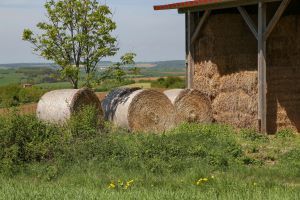
Whether you have recently cut hay or have stored in the barn, your hay could be a significant wildfire concern. Having spent the past 20 years as a Chubb Personal Risk Consultant located in central Texas, I’ve visited numerous farms and ranches and one thing remains a core concern; will they survive a wildfire?
Over the past five years in the U.S., more than 306,000 wildfires have burned over 39 million acres. Given the proximity of the nation’s farms and ranches to rural wildlands, the risk of fire, always a concern, is increasing.
As a teenager, I worked summers at my uncle’s ranch in East Texas, where he raised cattle, horses, hogs, chicken and sheep. About 25 acres of the ranch were dedicated to growing hay, a highly combustible commodity.
When the internal temperature of cut hay rises above 130 degrees Fahrenheit and the moisture content is 20 percent or higher, a chemical reaction releases flammable gas that can ignite if the temperature is high enough. Indeed, although it seems counterintuitive, dry hay is at less risk of catching fire than wet hay. At the ranch, we took many precautions at harvest time to ensure the hay would dry out completely. Likewise, vigilance is required to ensure the internal temperature of hay does not exceed 130 degrees – a challenge given the fluctuating temperature of barns. My uncle used a hay thermometer and plenty of good ventilation to make sure this was the case.
These memories come to mind for a reason: What used to be called the wildfire season seems to start sooner and last longer. The heightened risks require ranches and farms to take advance preparations to reduce wildfire-related losses. Here’s some tips to consider in creating a farm or ranch wildfire preparedness plan:
- Make sure hay is dry before storing it. Measure the moisture content before the hay is stacked in round or square bales. Consider buying a digital hay moisture meter, a useful tool to test the moisture of many crops. Simply fill a bucket with tightly compacted hay, insert the tester probe and get a reading.
- Wait until the dew has evaporated before raking hay, preferably in the hot afternoon sun. Continually overturn the hay, as it increases evaporation. Then, let it sit for a couple hours or more before baling. An old rule of thumb is to twist the stems of hay before baling; if they break easily, it’s indicative of dry hay. To be certain, insert the moisture probe.
- In the barn, keep only a limited number of needed electrical appliances. Forbid smoking or open flames. To prepare the defensible space, remove flammable vegetation, lawn furniture and gas grills within 30 feet of all structures.
- Monitor the internal temperature of hay stored in the barn on a routine basis, such as every other day or twice per week. Create a calendar with these days checked off with that day’s internal temperature.
- Some barns are a century-old and others are newer, state-of-the-art facilities. Older barns may lack proper ventilation to limit moisture and heat accumulations. In such cases, keep doors and windows open at both ends to ventilate the air. If the barn is completely closed, consider hiring a contractor to install a modern ventilation system. The key here for proper guidance is in barn ventilation of stored hay, not quantity of hay. If there is good air flow, allowing for removal of moisture, the amount of hay should only be restricted by the barn size.
Another important risk consideration is the ingress and egress needed by firefighters to extinguish a fire. Fences, gates, low-hanging tree branches and narrow roads and bridges can frustrate a large fire truck in reaching the scene of the fire. Always leave the lights on inside and outside ranch and farm structures so firefighters can locate the scene of the fire at night or in smoke-dense situations. Identify on-site emergency water supplies for firefighters with lighting and signage.
Lastly, identify all possible evacuation routes and limiting factors, in case one or more routes are blocked by fire. And take the threat of wildfires seriously. As the USDA recently announced, wildfire season is all seasons.
Glenn Tompkins is a Risk Consultant with Chubb Personal Risk Services.
The opinions and positions expressed are the authors’ own and not those of Chubb. The information and/ or data provided herein is for informational purposes only and is not a substitute for professional advice. Insurance coverage is subject to the language of the policies as issued.